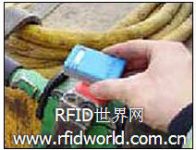
UK’s largest construction steel provider uses RFID to measure hand-arm vibration tolerance
[ad_1]
Severfield-Rowen, a British construction steel producer, uses Reactec’s RFID system to measure construction workers’ hand-arm vibration (HAV), which has met European HAV tolerance levels. Peripheral vascular dysfunction easily caused by long-term engagement in hand-transmitted vibration operations (such as hand-held power tools). Construction companies have been tracking the impact of strong vibrations on construction workers from mechanical tools such as jackhammers, lawn mowers and drills, due to EU regulations on the amount of vibration workers are exposed to.

Most companies require employees to manually record or calculate the amount of vibration they experience, multiplied by the time, which is time-consuming and inaccurate. Now a group of RFID technology providers, including Reactec, have introduced another automated approach. According to Reactec managing director Mark-Paul Buckingham, paper recording systems typically expand HAV capacity by a factor of 10 compared to Reactec’s automated technology. In most cases, workers use jackhammers and other power tools for so little time, he said, that it is almost impossible for workers to accurately measure vibration tolerance, while RFID sensors can measure down to the minute.
Severfield-Rowen, the UK’s largest provider of construction steel, was looking for an efficient solution for tracking HAVs, according to company health and safety manager David Atkinson. After reviewing several products, the company settled on Reactec’s RFID system and conducted several months of testing.
The system requires that each tool be affixed with a passive high-frequency 13.56 MHz RFID tag and HAVmeter, which contains an accelerometer and other sensors that can detect tool operation, and an RFID reader that receives data from the tool’s RFID tag. The tags are designed and supplied by CoreRFID and are ISO 15693 compliant. Each tag contains a unique ID code, along with other data such as the tool’s service history, serial number and description, level and source of vibration.
At the start of the shift, Severfield-Rowen employees arrive at a Reactec base station, where multiple HAVmeters are connected to Reactec backend systems, magnetic stripe card readers and keypads. The employee can use the magnetic stripe card reader to swipe the magnetic stripe on the employee ID card, or use the keypad to manually enter the employee’s ID code. The base station connects the device’s ID code with the employee’s ID code, assigns a HAVmeter to the employee, and then flashes the indicator light on the HAVmeter. The employee takes the HAVmeter and, after entering the work site, attaches the HAVmeter to the RFID tag of the tool he wants to use with a magnet.
The HAVmeter then reads the tool’s tag, which provides the device with its ID code and other vibrations including the amount of vibration generated during operation of the tool. HAVmeter’s sensors detect when the tool is running, and then use the built-in timer to track how long the tool has been used. When the worker switches to another tool, he also uses the HAVmeter on the equipment. If the employee exceeds the safe level of vibration tolerance for a day, the HAVmeter starts flashing red.
When the employee finishes the day’s work, he sends the HAVmeter back to the base station, which downloads the data from the HAVmeter and transfers the data to Severfield-Rowen’s ERP system, where the Reactec software calculates the amount of vibration and displays a record of the employee’s use of the tool throughout the day. In this way, company management can determine the amount of vibration each employee is exposed to on a daily basis, as well as how often, when, and when the tools are used and repaired.
After testing, Atkinson said, Severfield-Rowen fully implemented the Reactec system in the third quarter of 2008, applying RFID tags to all angle grinding wheels and a variety of other tools, including needle guns. So far, he says, Severfield-Rowen has completed the labelling of 600 tools, and about 400 employees use the HAVmeter on a regular basis.
Currently Reactec has implemented RFID HAVmeter systems for 62 customers, the vast majority in the UK. Uckingham predicts that Europe and North America will also be interested in the system, however, so far there is no HAV regulation in the US.
[ad_2]



